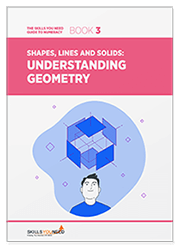Three-Dimensional Shapes:
Polyhedrons, Curved Solids and Surface Area
See also: Properties of Polygons
This page examines the properties of three-dimensional or ‘solid’ shapes.
A two-dimensional shape has length and width. A three-dimensional solid shape also has depth. Three-dimensional shapes, by their nature, have an inside and an outside, separated by a surface. All physical items, things you can touch, are three-dimensional.
This page covers both straight-sided solids called polyhedrons, which are based on polygons, and solids with curves, such as globes, cylinders and cones.
Polyhedrons
Polyhedrons (or polyhedra) are straight-sided solid shapes. Polyhedrons are based on polygons, two dimensional plane shapes with straight lines.
See our page Properties of Polygons for more about working with polygons.
Polyhedrons are defined as having:
- Straight edges.
- Flat sides called faces.
- Corners, called vertices.
Polyhedrons are also often defined by the number of edges, faces and vertices they have, as well as whether their faces are all the same shape and size. Like polygons, polyhedrons can be regular (based on regular polygons) or irregular (based on irregular polygons). Polyhedrons can also be concave or convex.
One of the most basic and familiar polyhedrons is the cube. A cube is a regular polyhedron, having six square faces, 12 edges, and eight vertices.
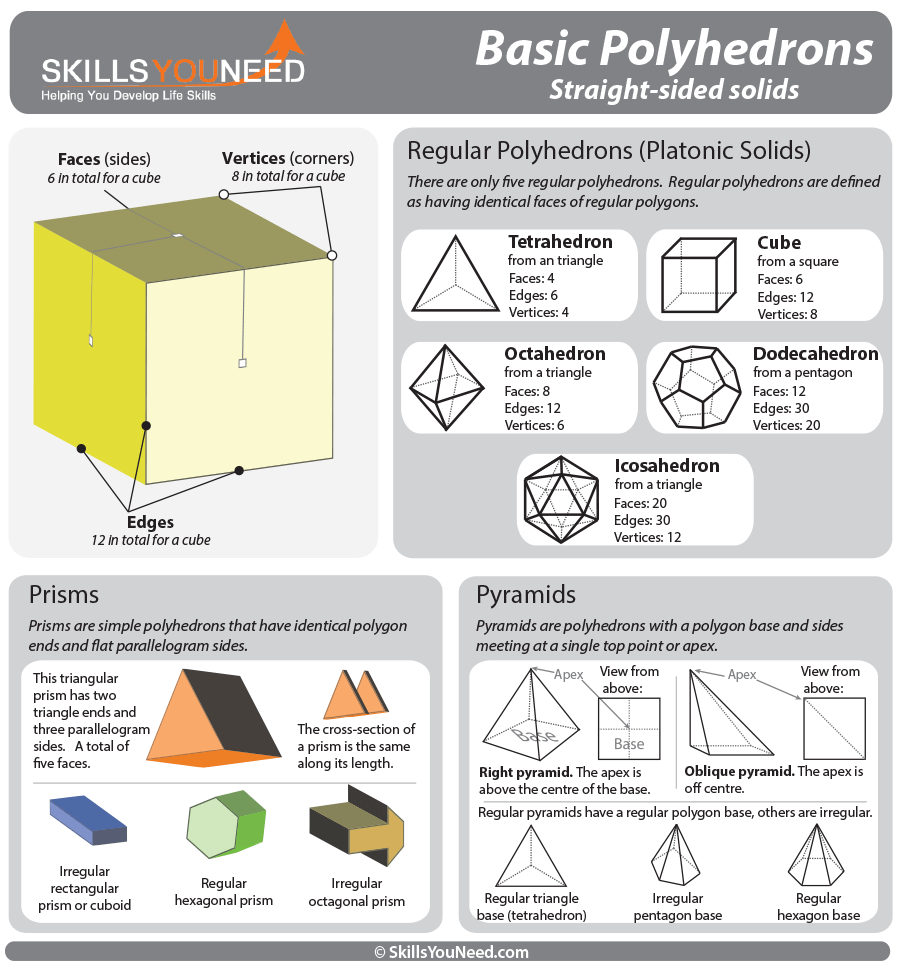
Regular Polyhedrons (Platonic Solids)
The five regular solids are a special class of polyhedrons, all of whose faces are identical, with each face being a regular polygon. The platonic solids are:
- Tetrahedron with four equilateral triangle faces.
- Cube with six square faces.
- Octahedron with eight equilateral triangle faces.
- Dodecahedron with twelve pentagon faces.
- Icosahedron with twenty equilateral triangle faces.
See the diagram above for an illustration of each of these regular polyhedrons.
What is a Prism?
A prism is any polyhedron that has two matching ends and flat sides. If you cut a prism anywhere along its length, parallel to an end, its cross-section is the same - you would end up with two prisms. The sides of a prism are parallelograms - four-sided shapes with two pairs of sides of equal length.
Antiprisms are similar to regular prisms in that, their ends match. However the sides of anti-prisms are made up of triangles and not parallelograms. Antiprisms can become very complex.
What is a Pyramid?
A pyramid is a polyhedron with a polygon base that connects to an apex (top point) with straight sides.
Although we tend to think of pyramids with a square base, like the ones that the ancient Egyptians built, they can in fact have any polygon base, regular or irregular. Furthermore, a pyramid can have an apex in the direct centre of its base, a Right Pyramid, or can have the apex off centre when it's an Oblique Pyramid.

More Complex Polyhedrons
There are many more types of polyhedra: symmetrical and asymmetrical, concave and convex.
Archimedean solids, for example, are made up of at least two different regular polygons.
The truncated cube (as illustrated) is an Archimedean solid with 14 faces. Six of the faces are regular octagons and the other eight are regular (equilateral) triangles. The shape has 36 edges and 24 vertices (corners).
Three-Dimensional Shapes with Curves
Solid shapes which include a curved or round edge are not polyhedrons. Polyhedrons can only have straight sides. Also see our page on two-dimensional Curved Shapes.
Many of the objects around you will include at least some curves. In geometry the most common curved solids are cylinders, cones, spheres and tori (the plural for torus).
| Common Three-Dimensional Shapes with Curves: | |
|---|---|
| Cylinder | Cone |
 |
 |
| A cylinder has the same cross-section from one end to the other. Cylinders have two identical ends of either a circle or an oval. Although similar, cylinders are not prisms as a prism has (by definition) parallelogram, flat sides. | A cone has a circular or oval base and an apex (or vertex). The side of the cone tapers smoothly to the apex. A cone is similar to a pyramid but distinct as a cone has a single curved side and a circular base. |
| Sphere | Torus |
 |
 |
| Shaped like a ball or a globe a sphere is a completely round object. Every point on the surface of a sphere is an equal distance to the centre of the sphere. | Shaped like a ring, a tyre or a doughnut, a regular ring torus is formed by revolving a smaller circle around a larger circle. There are also more complex forms of tori. |
Surface Area
Our page on Calculating Area explains how to work out the area of two-dimensional shapes and you need to understand these basics in order to calculate the surface area of three-dimensional shapes.
For three-dimensional shapes, we talk about surface area, to avoid confusion.
You can use your knowledge about the area of two-dimensional shapes to calculate the surface area of a three-dimensional shape, since each face or side is effectively a two-dimensional shape.
You therefore work out the area of each face, and then add them together.
As with flat shapes, the surface area of a solid is expressed in square units: cm2, inches2, m2 and so on. You can find more detail about units of measurement on our page Systems of Measurement.
Examples of Surface Area Calculations

Cube
The surface area of a cube is the area of one face (length x width) multiplied by 6, because all six faces are the same.
As the face of a cube is a square you only need to take one measurement - the length and width of a square are, by definition, the same.
One face of this cube is therefore 10 × 10 cm = 100cm2. Multiply by 6, the number of faces on a cube, and we find that the surface area of this cube is 600cm2.
Other Regular Polyhedrons
Similarly, the surface area of the other regular polyhedrons (platonic solids) can be worked out by finding the area of one side and then multiplying the answer by the total number of sides - see the Basic Polyhedrons diagram above.
If the area of one pentagon making up a dodecahedron is 22cm2 then multiply this by the total number of sides (12) to give the answer 264cm2.
Pyramid
To calculate the surface area of a standard pyramid with four equal triangular sides and a square base:
First work out the area of the base (square) length × width.
Next work out the area of one side (triangle). Measure the width along the base and then the height of the triangle (also known as slant length) from the central point on the base to the apex.
There are then two ways to calculate the surface area of the four triangles:
Divide your answer by 2 to give you the surface area of one triangle and then multiply by 4 to give the surface area of all four sides, or
Multiply your answer by 2.
Finally add the area of the base and sides together to find the total surface area of the pyramid.
To calculate the surface area of other types of pyramid, add together the area of the base (known as base area) and the area of the sides (lateral area). You may need to measure the sides individually.
Net Diagrams
A geometric net is a two-dimensional 'pattern' for a three dimensional object. Nets can be helpful when working out the surface area of a three-dimensional object. In the diagram below you can see how basic pyramids are constructed, if the pyramid is 'unfolded' you are left with the net.

For more on net diagrams see our page 3D Shapes and Nets.

Prism
To calculate the surface area of a prism:
Prisms have two ends the same and flat parallelogram sides.
Calculate the area of one end and multiply by 2.
For a regular prism (where all the sides are the same) calculate the area of one of the sides and multiply by the total number of sides.
For irregular prisms (with different sides) calculate the area of each side.
Add your two answers together (ends + sides) to find the total surface area of the prism.
Cylinder
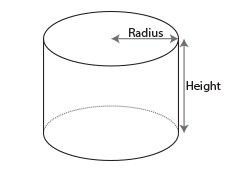
Example:
Radius = 5cm
Height = 10cm
To calculate the surface area of a cylinder it is useful to think about the component parts of the shape. Imagine a tin of sweetcorn - it has a top and a bottom, both of which are circles. If you cut the side along its length and flattened it you would have a rectangle. You therefore need to find the area of two circles and a rectangle.
First work out the area of one of the circles.
The area of a circle is π (pi) × radius2.
Assuming a radius of 5cm, the area of one of the circles is 3.14 × 52 = 78.5cm2.
Multiply the answer by 2, as there are two circles 157cm2
The area of the side of the cylinder is the perimeter of the circle × the height of the cylinder.
Perimeter is equal to π x 2 × radius. In our example, 3.14 × 2 × 5 = 31.4
Measure the height of the cylinder - for this example the height is 10cm. The surface area of the side is 31.4 × 10 = 314cm2.
The total surface area can be found by adding the area of the circles and the side together:
157 + 314 = 471cm2
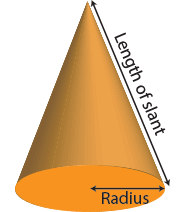
Example:
Radius = 5cm
Length of Slant = 10cm
Cone
When calculating the surface area of a cone you need to use the length of the ‘slant’ as well as the radius of the base.
However, it is relatively straightforward to calculate:
The area of the circle at the base of the cone is, π (pi) × radius2.
In this example the calculation is 3.14 × 52 = 3.14 × 25 = 78.5cm2
The area of the side, the sloping section, can be found using this formula:
π (pi) × radius × length of slant.
In our example the calculation is 3.14 × 5 × 10 = 157cm2.
Finally add the base area to the side area to get the total surface area of the cone.
78.5 + 157 = 235.5cm2

Tennis Ball:
Diameter = 2.6 inches
Sphere
The surface area of a sphere is a relatively simple expansion of the formula for the area of a circle.
4 × π × radius2.
For a sphere it is often easier to measure the diameter - the distance across the sphere. You can then find the radius which is half of the diameter.
The diameter of a standard tennis ball is 2.6 inches. The radius is therefore 1.3 inches. For the formula we need the radius squared. 1.3 × 1.3 = 1.69
The surface area of a tennis ball is therefore:
4 × 3.14 × 1.69 = 21.2264 inches2.
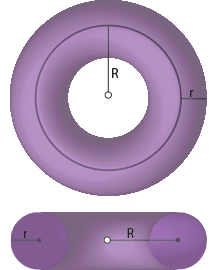
Example:
R (Large Radius) = 20 cm
r (Small Radius) = 4 cm
Torus
In order to calculate the surface area of a torus you need to find two radius values.
The large or major radius (R) is measured from the middle of the hole to the middle of the ring.
The small or minor radius (r) is measured from the middle of the ring to the outside edge.
The diagram shows two views of an example torus and how to measure its radiuses (or radii).
The calculation to find the surface area is in two parts (one for each radius). The calculation is the same for each part.
The formula is: surface area = (2πR)(2πr)
To work out the surface area of the example torus.
(2 × π × R) = (2 × 3.14 × 20) = 125.6
(2 × π × r) = (2 × 3.14 × 4) = 25.12
Multiply the two answers together to find the total surface area of the example torus.
125.6 × 25.12 = 3155.072cm2.
Further Reading from Skills You Need
Understanding Geometry
Part of The Skills You Need Guide to Numeracy
This eBook covers the basics of geometry and looks at the properties of shapes, lines and solids. These concepts are built up through the book, with worked examples and opportunities for you to practise your new skills.
Whether you want to brush up on your basics, or help your children with their learning, this is the book for you.
Filling up a Solid: Volume
With three-dimensional shapes, you may also need to know how much volume they have.
In other words, if you filled them up with water or air, how much filling would you need?
This is covered on our page Calculating Volume.

